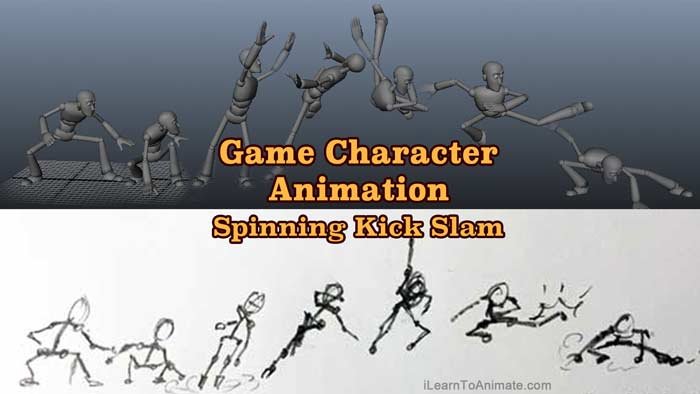
Spinning kick slam is a fighting action for game character animation. The character jumps forward, somersault spins in the air and slams on the opponent with his leg. Game character animation is mostly quick and easy to understand from all camera angles. This is unlike acting animation which has lots of expression through body language.
In this post, I'll share:
- Game Character Animation Result And Planning
- 4 Human Mechanic's Applied
Game Character Animation Result And Planning
I wanted to create a fighting action but I needed something more exciting. I wanted an action that has strong impact on the motion.
Also, after watching SEA games, I wanted an action not just standing and fighting. So based on my game experience, I had a spin kick action in my mind. I drew it out and it looks like this.

Now I've gotten my idea down on paper, I can work on my animation. Here are the comparison between my initial idea and my final pose.
Standing idle pose has almost 100% similarity from idea to execution.
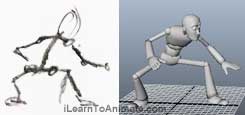
Squatting pose has been slightly modified. Instead of left hand posed to the front, I've put the right hand on the ground. This allows the chest to be facing front, a better pose to look at the target.

Leaping pose is only 50% similar. In my sketch, I realized that the torso twisted too early, so I maintained it to face the front.
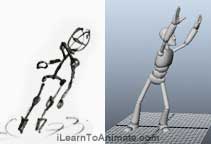
The arms are pointing down in my sketch which makes the character looks like he is comfortably leaping. No way! I want him to look as if he is exerting tremendous force while jumping. So I make him swing his arms forward.
Twisting pose differs in the arms position. The character was choreographed to swing the arm forward in the sketch, but it's was still too early for that action. Thus the arms are "dragged" behind, allowing the body mass to take the lead.
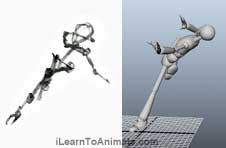
Somersault pose looks quite similar, except the arms are still lagging behind. (The sketch did not do a good job explaining which is leg and which is arm). By lagging the arms behind, visually it looks like the character is preparing for something, which I'll explain later in the post.
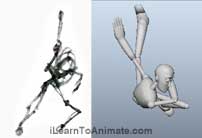
Slamming pose is almost 100% similar, hitting the target with a bad@$$ kick.

Landing pose does not have much discrepancy either, except the right arm is raised in the air. I find this pose in 3d looks more balance and cool, just my personal preference.

Finally, my end result. I've created this animation draft using my sketches for the purpose of sharing on my post (i.e. draft created after my 3d animation is done). This is just to help me get a better idea to compare my blocking phase against my final 3d animation.
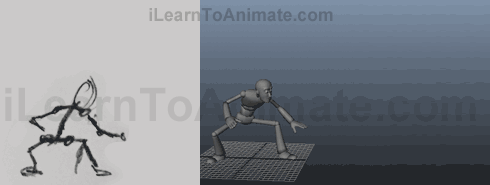
For industry practice, it is actually the reverse. It is a good practice sketch the initial poses and create a draft animation before development. This helps to reduce amendments when the animation process starts.
I'm satisfied! And I hoped you are entertained!
Animation Process Recorded!
Watch the entire process of creating my game character animation: Spinning Slam Kick!
(A 100 minutes process compressed into 10 minutes.)
Now, I'll share the 4 human mechanics inputs I've included in this game character animation.
1. Line of Action
2. Energy Burst
3. Balance
4. Momentum
Human Mechanics Consideration For Game Character Animation
Line of action
When I think about human mechanics, I think of line of action.
Line of action refers the flow of the body shape which resembles the shape of a C and not a S shape. So, I try to follow this concept when I'm planning a human's action.
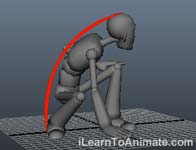
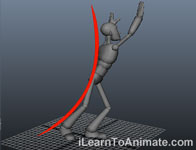
For example, in the squatting pose, the line of action is seen like a bent curve. This makes the character looks like a ball, round and compressed, like a C shape.
Another instance is when the character jumps up. The character is stretched open, arching the body back, creating a reverse C curve. Again, the line of action is a nice gentle curve.
Energy Burst
 To create a burst of energy, theoretically, there must be a huge amount of energy stored before the burst can happen. There are two instances in this slam kick animation that I applied this burst of energy.
To create a burst of energy, theoretically, there must be a huge amount of energy stored before the burst can happen. There are two instances in this slam kick animation that I applied this burst of energy.
Jumping into the air requires a huge amount of energy. So jumping is the burst action, thus I needed an action to store the energy. That would be the squatting pose, which creates a "recoil" before executing the jump.
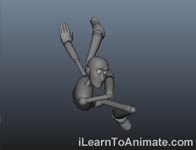 Another energy burst instance is creating the kick slam from mid air. This is the critical moment of the character wanting to hit his opponent really hard. The force needed here is tremendous, but where does the character gets his energy from?
Another energy burst instance is creating the kick slam from mid air. This is the critical moment of the character wanting to hit his opponent really hard. The force needed here is tremendous, but where does the character gets his energy from?
It has to come from the torso. Twisting the torso creates a centripetal force, which transmit energy down to the pelvis and the leg. This will be the burst action.
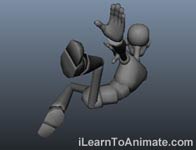 To create the stored energy before the burst, the character compresses his core, as if doing an abs exercise.
To create the stored energy before the burst, the character compresses his core, as if doing an abs exercise.
Again, when the torso is compressed, huge amount of energy is stored. The torso eventually unwind and twist out like a spring, bursting into a strong centripetal force.
Arm's Motion
In human's movement, arm's motion is there to keep the person balance or to create momentum.
Balance
During neutral pose, the character's arms are fairly spaced apart from the body. This helps the character to gain a stable pose. And because the arms are spaced out, the character can react quickly if he loses balance.

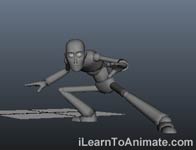
When the character lands, his arms are spread apart widely. This is a common human reaction after a jump because we are trying to recover ourselves to a balance position.
But why 2 arms?
If we only have one arm apart, our center of gravity will be off the center of our body. Using two arms allows the character to adjust his CG by bending the elbow or stretching the arms.
Momentum
We can gain momentum in motion by swinging our arms.
In this animation, I throw the character's arm forward when jumping. This helps to give an extra push to the character's motion on top of the force from his legs.
This combination will make the character looks like he can jump higher and further.
I've also used the arms to create a stronger leg slam in this animation.
How?
The arms are swung across the body from left to right while the torso is twisting. In this scenario, the upper torso is the primary force.
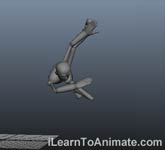
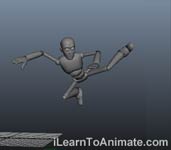
The swinging arms, together with the twisting torso, drives the energy down to the lower torso. Thus, the pelvis and the leg are able to rotate harder.
Now I Got A Question For You
Do you apply human mechanics when creating a game character animation?
Let me know by leaving a quick comment right now.
Or maybe you have a question about this animation approach.
I'm usually online to answer your comments.
So if you have a thought or question, let me know in the comment box below!
